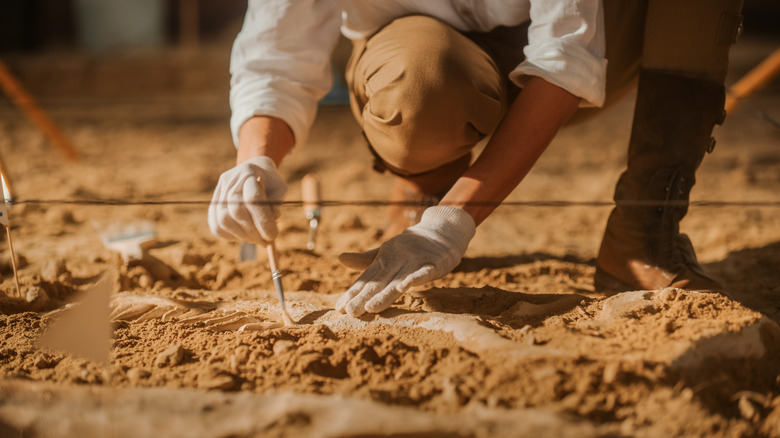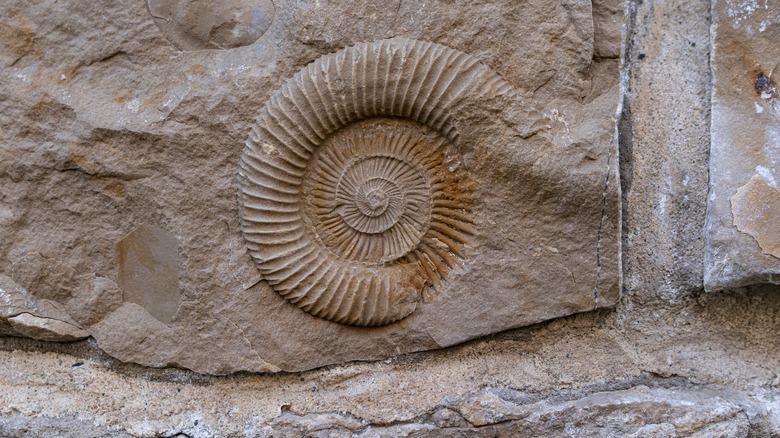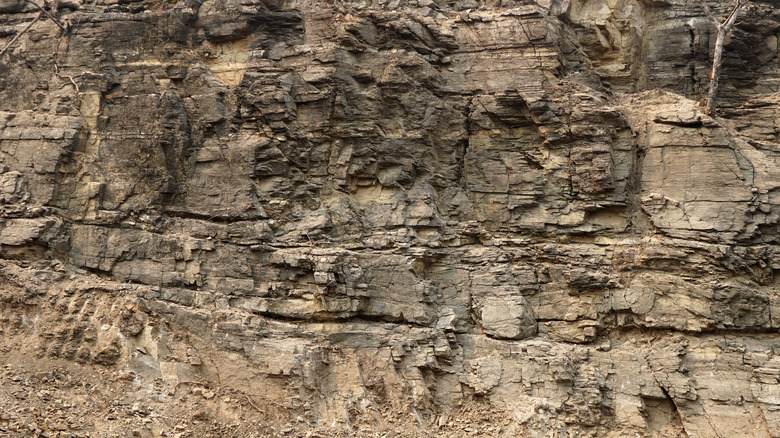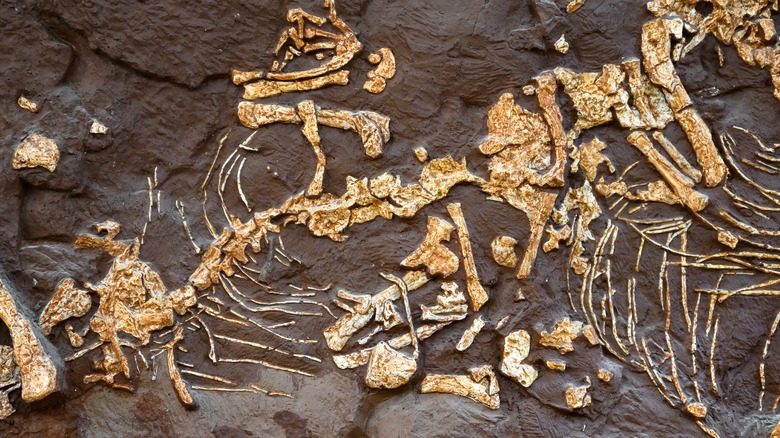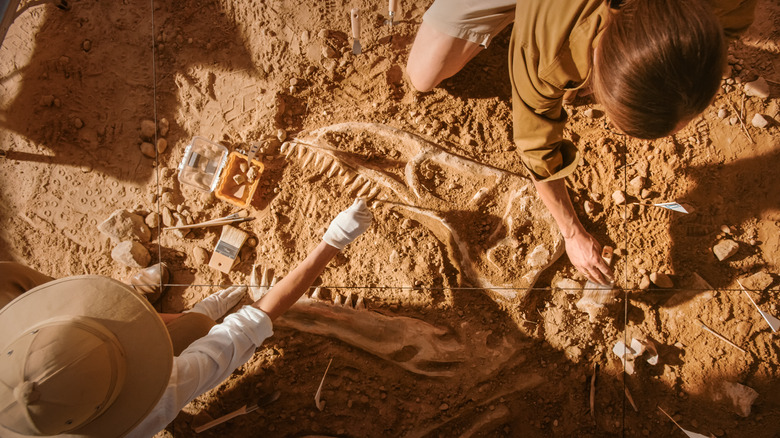How Scientists Are Able To Determine The Age Of Fossils
In 1677, Robert Plot discovered the first ever dinosaur fossil (via Discovery). According to American Scientist, Plot, who was the director of the Ashmolean Museum in Oxford, England, mistakenly believed the large femur bone was that of a giant human. Then in 1824, William Buckland, a geology professor at Oxford, surmised that the bone actually belonged to a massive reptile he termed Megalosaurus. Although Buckland's guess was inaccurate, he is credited with being the first to positively identify a dinosaur. Since then, Scientific American states, 11,000 dinosaur fossils have been discovered all over the world. Additionally, 1,000 different species and counting have been identified.
National Geographic explains that fossils are remnants of animals and plants from the past. These remains, however, are preserved in rocks. Per the Natural History Museum, London, fossils are formed when an animal dies and decomposes, leaving behind only bones. The Australian Museum writes that these remains are then buried by sediment and eventually formed into rocks. Besides bones, fossils can include bacteria, as well as plant and animal tissue. The Smithsonian's Human Origins Program reports that fossils provide insight into the past, including how animals lived, ate, and more. That being said, fossils take centuries to form. When a fossil is found, the first task involves figuring out how old it is (per Smithsonian Magazine).
There are two different dating methods
The Australian Museum explains that fossils are unearthed through the process of erosion. Simply put, when the rocks are weathered away by the elements or by the movement of the Earth's plates, the fossils emerge on the surface, thus revealing themselves (via the Natural History Museum). To uncover their age, The Botanic Garden of Smith College states, scientists use two methods; relative and absolute dating. Relative dating, per The Smithsonian's Human Origins Program, uses geology to provide scientists with an estimated age. However, The American Museum of Natural History writes that this method is still significant as it allows scientists to put fossils in chronological order.
When it comes to absolute dating methods, another article from the Australian Museum reports that radioactive elements determine an accurate age of a fossil. This process is called radiometric dating and involves analyzing the decay of uranium, potassium, and carbon (via The Smithsonian's Human Origins Program). Although the true age of a fossil cannot be 100% determined, absolute dating methods yield a more precise age. The Paleontological Research Institute notes that the fossils themselves are not composed of radioactive elements. Therefore, rock layers are used to provide an age for the fossils. Nevertheless, various methods are commonly used multiple times to get an accurate answer.
Scientists first use relative dating methods
Before scientists provide fossils with an absolute age, Smithsonian Magazine writes that they first use relative dating methods. That being said, The Botanic Garden of Smith College states that this process is centered on where a fossil is found in sedimentary rock layers. The Paleontological Research Institute notes that it's assumed that the bottom layers are older, while the newest layer is at the top. Scientists then study these layers to determine the age of a fossil. The Smithsonian's Human Origins Program reports that this is called stratigraphy. Using this concept, scientists are able to ascertain whether fossils found in different layers are older or younger.
In simple terms, fossils found in the bottom layers are considered to be older while fossils found on the top layers are labeled as younger. The American Museum of Natural History explains that this allows scientists to place fossils in chronological order, even if they don't have an actual age. Per the Australian Museum, this is called biostratigraphy. Ultimately, this allows scientists to date fossils found in similar layers at other locations (via Paleontological Research Institute).
Furthermore, scientists use paleomagnetic stratigraphy. This strategy involves the Earth's magnetic field and its direction. Over the course of thousands of years, the Earth's magnetic field can shift positions in a process known as a magnetic reversal. Scientists can use records of these known reversals to deduce the date of a fossil (per The Smithsonian's Human Origins Program).
Geologic time and index fossils
Per the Paleontological Research Institute, relative dating methods led to the creation of the Geologic Time Scale. This is thanks to the study of rock layers and the conclusion that this can calculate the ages of fossils. However, the Geologic Time Scale would not be possible if it weren't for index fossils (via The Smithsonian's Human Origins Program). Britannica writes that an index fossil must be representative of a specific time and era for it to be used on the Geologic Time Scale. The National Park Service states that the time scale is divided into four periods of time: the Cenozoic Era, Mesozoic Era, Paleozoic Era, and the Precambrian.
ThoughtCo. explains that many of these eras involved mass extinction events — that is to say that certain fossils have been used to determine geological periods and their time span. The Smithsonian's Human Origins Program reports that, ultimately, index fossils can be used to determine the age of the rock layers that they are found. In this way, index fossils can provide scientists with an estimated age for new fossil discoveries (via Fossilera).
Absolute dating methods
According to The Botanic Garden of Smith College, absolute dating involves using radioactive elements found in rocks. Fossilera describes this process as functioning like a clock. This is because radioactive elements break down at a certain rate (per The Smithsonian's Human Origins Program). As radioactive elements in the rocks break down, scientists can roughly calculate when the fossil was formed or when the species died. The Paleontological Research Institute explains that this allows scientists to determine how long the element has been in the rock. Similarly, scientists can measure the amount of carbon-14 in fossils using particle accelerators to establish an age.
Fossilera notes that this method, known as carbon dating, can only be used when a fossil is younger than 75,000 years. Per the Australian Museum, there are various other methods that can be used when it comes to absolute dating, including measuring uranium in fissions (cracks found in rocks). Smithsonian Magazine notes that absolute dating has led to colossal discoveries, such as the age of the Earth and a time frame for evolution.
New tools are helping scientists date fossils
Per Smithsonian Magazine, advances in technology are aiding scientists to obtain the ages of fossils. This includes electron spin resonance, which the Encyclopedia of Global Archaeology describes as an older method that determines the age of a fossil by measuring the amount of radiation absorbed by the specimen compared to the radiation where it was found. Smithsonian Magazine notes that this method has been improved to prevent the fossil from becoming damaged.
Another method is called optically stimulated luminescence. Baylor University explains that this can determine when sediment was last exposed to light, which in turn can provide an age. The Botanic Garden of Smith College reports that volcanic ash formed into rocks can also be used to age fossils. When ash cools, the potassium-40 inside volcanoes breaks down into argon. Scientists can compare the amount of these radioactive elements to uncover when the volcanic rock was formed. Whatever method is used to date fossils, Smithsonian Magazine writes, the goal remains to accurately paint a picture of Earth's history.
